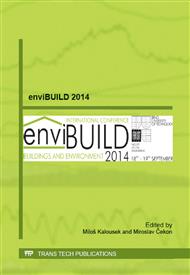p.43
p.47
p.51
p.55
p.59
p.63
p.67
p.71
p.75
Non-Traditional Thermal-Insulating and Rehabilitation Materials and their Hygrothermal Behaviour
Abstract:
The development of non-traditional, thermal insulation plaster leads to the development of new eco-efficient materials suitable for insulation and rehabilitation of both existing and new building structures. Optimal function of these materials is then to reduce the energy consumption of buildings. This is beneficial from an environmental perspective. In addition, the development of new, promising, thermal insulation plaster was used innovative, environmentally friendly binders, such as substitution for energy intensive binder - cement. The paper presents the results of development of thermal insulation plaster and research in their hygrothermal behaviour.
Info:
Periodical:
Pages:
59-62
Citation:
Online since:
October 2014
Authors:
Price:
Сopyright:
© 2014 Trans Tech Publications Ltd. All Rights Reserved
Share:
Citation:


